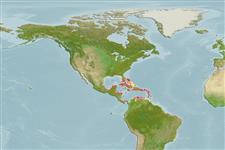>
Blenniiformes (Blennies) >
Labrisomidae (Labrisomids)
Etymology: Paraclinus: Greek, para = the side of + Greek, klinein, kline = sloping and bed, due to the four apophyses of sphenoid bone (Ref. 45335).
More on author: Steindachner.
Environment: milieu / climate zone / depth range / distribution range
ນິເວດວິທະຍາ
ສັດທະເລ ກ່ຽວກັນຫີນ; ລະດັບຄວາມເລິກ 0 - 2 m (Ref. 9710). Tropical; 33°N - 6°N, 99°W - 58°W
Western Atlantic: Florida, USA and the Bahamas (including northern Gulf of Mexico) to Central and northern South America.
ຂະໜາດ / ນ້ຳໜັກ / Age
Maturity: Lm ? range ? - ? cm
Max length : 6.5 cm TL ຕົວຜູ້/ບໍ່ມີເພດ; (Ref. 7251)
ຄີ (ໜາມ)ແຂງຢູ່ຫຼັງປາ (ທັງໝົດ) : 29 - 32; ຄີຫຼັງຂອງປາ (ຄີອ່ອນ) (ທັງໝົດ) : 0; ຄີ(ໜາມ) ແຂງຢູ່ຄີກົ້ນປາ
ກຸ່ມປາກະດູກແຂງ
ຄວາມຖີ່ຂອງກຸ່ມຖ່າຍທອດພັນ
ປາທີ່ມີການເຄື່ອນຍ້າຍຈາກທະເລໄປຫານ້ຳຈືດ ແລະນ້ຳຈືດຫາທະເລ
ປາທີ່ມີການເຄື່ອນຍ້າຍຈາກທະເລແລະໄປໄຂ່ຢູ່ນ້ຳຈືດ
ຄີກົ້ນຂອງປາ
ສັດທີ່ມີກະດູກສັນຫັຼງ
ການຖ່າຍທອດທາງກຳມະພັນຈາກພໍ່ແມ່ຫາລູກ: 2; ຄີກົ້ນຂອງປາ: 18 - 20. Color varies from uniform dark brown to light brown with dark bars (Ref. 13442).
Occurs in protected shallow waters, in coral, rock or sand bottoms (Ref. 5521) especially in seagrass beds (Ref. 7251).
Carnivorous; diet may vary according to seasonal and spatial changes in prey species abundance. Preys on a few species of amphipods as juveniles and shift to diet of crabs, shrimp and isopods (Ref. 94105).
Life cycle and mating behavior
Maturities | ການສືບພັນ | Spawnings | Egg(s) | Fecundities | ຕົວອ່ອນ
Robins, C.R. and G.C. Ray, 1986. A field guide to Atlantic coast fishes of North America. Houghton Mifflin Company, Boston, U.S.A. 354 p. (Ref. 7251)
IUCN Red List Status (Ref. 130435)
Threat to humans
Harmless
Human uses
ການປະມົງ: ເປັນສີນຄ້າ
ເຄື່ອງມື
Special reports
Download XML
ແຫຼ່ງອີນເຕີເນັດ
Estimates based on models
Preferred temperature (Ref.
123201): 26.1 - 28.2, mean 27.4 °C (based on 429 cells).
Phylogenetic diversity index (Ref.
82804): PD
50 = 0.5000 [Uniqueness, from 0.5 = low to 2.0 = high].
Bayesian length-weight: a=0.00813 (0.00388 - 0.01704), b=3.03 (2.84 - 3.22), in cm total length, based on LWR estimates for this species & (Sub)family-body (Ref.
93245).
ຊັ້ນເຂດຮ້ອນ (Ref.
69278): 3.5 ±0.4 se; based on size and trophs of closest relatives
Fishing Vulnerability (Ref.
59153): Low vulnerability (10 of 100).
Nutrients (Ref.
124155): Calcium = 155 [78, 317] mg/100g; Iron = 0.85 [0.45, 1.54] mg/100g; Protein = 18.9 [17.6, 20.0] %; Omega3 = 0.131 [0.069, 0.249] g/100g; Selenium = 11.4 [5.0, 26.5] μg/100g; VitaminA = 248 [68, 919] μg/100g; Zinc = 2.43 [1.53, 3.69] mg/100g (wet weight);
